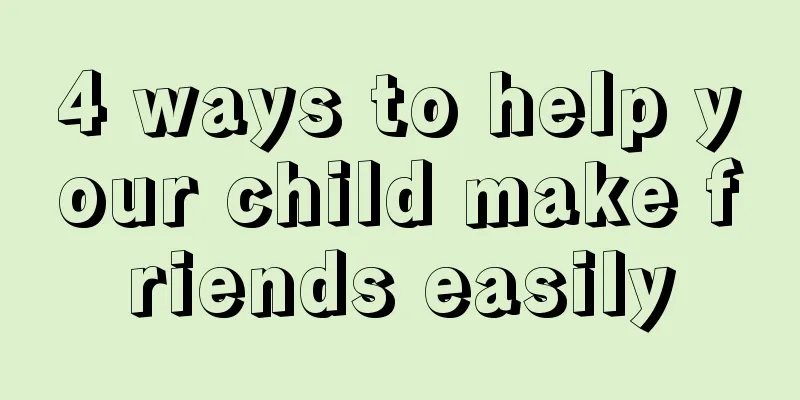What will happen to babies who can't crawl in the future? What are the dangers of not crawling?

|
Crawling is one of the abilities of babies. When parents find that their babies can crawl, they will feel that their babies have entered another stage of life. However, some babies cannot crawl. Does not crawling have any impact on the baby's development? Let's tell you today. How many months does the baby crawl?Most babies learn to crawl between 6 and 10 months of age. However, during this period, your baby may also adopt other ways of moving, such as rubbing (pushing around with one hand behind the body and one foot in front of the body), crawling on the belly, or rolling. Some babies will skip the crawling stage entirely and go straight to learning to stand up, stand, and walk. When the baby is seven or eight months old, he will crawl. When he really crawls, he crawls on his hands and knees, with his head and neck raised and his chest and abdomen off the bed. Crawling is a very beneficial action for babies. It can not only exercise the strength and coordination of the baby's muscles throughout the body, but also enhance the sense of balance of the cerebellum. It has a good influence on the baby's future learning of language and reading. Therefore, mom and dad must help the baby complete the crawling action. Safety tips for babies after they learn to crawl When babies reach the crawling stage, the dangerous places or objects they are likely to encounter become more diverse. Parents must pay attention to the following places where accidents are prone to occur. 1. Floor: Floors made of cement, terrazzo, tiles, etc. are prone to falling down accidentally for babies who are learning to crawl, which can cause irreparable regrets. To avoid danger, you can lay a cushion on the hard floor, but be careful to use a thick cushion to play its role, and avoid buying cushions with many small patterns to prevent the baby from picking up the small patterns and eating them. 2. Table corners and cabinet corners: Sharp table corners or cabinet corners are simply a "danger zone" for babies who are learning to crawl. The way to improve it is to put protective pads on all table corners or cabinet corners. Even if the baby accidentally bumps into them, the damage can be minimized. 3. Electrical sockets: When babies crawl around, they may crawl near electrical sockets. If they are not careful, there is a risk of electric shock. Parents can use the protective cover of the electrical socket, install this device on the unused socket or use a safety socket. 4. Prevent falls. Don't leave your baby alone in a bed, sofa, rocker, dining chair, changing table, or anywhere else he could fall from. Install guardrails, screens and safety screens on windows, patios and porches. If using blinds, choose draw cords with snaps. In a duplex house, protective doors should be installed at both ends of the stairs. If the railing is wider than 10 cm, block it with plastic garden fencing, plexiglass (plastic), or something else. When at the store, use the shopping cart's safety belt (or bring one of your own). There are 3 major concerns when your baby can't crawlNormally, babies will start crawling at eight or nine months old, but more and more parents find that their children are still not able to crawl, and some can even stand and walk but cannot crawl. Is this due to premature development or motor development disorder? Mai Jianning said that if a child does not crawl at the right time, there may be three reasons: brain damage, slow brain development, and improper parenting. If it is caused by brain damage or motor nerve damage, it is very likely that there will be motor impairment in the future, such as cerebral palsy, and even with early treatment, it is impossible to achieve the same motor skills as normal people. However, the probability of this happening is very low. Some children have transient retardation of brain development due to some reasons, which is mainly manifested in slow motor development, such as being able to sit at 8 months old, but clumsy, never able to crawl, or clumsy crawling. Some of these children may have motor coordination disorders in the future, but most children can reach normal levels as they grow older if they receive early training and treatment. Improper parenting is a human-caused cause. For example, children lack motor training since childhood, are usually carried or carried on their backs, or often use walkers improperly; their trunks, hands and feet rarely move actively, and when they are carried or carried on their backs, their waists always lean back, their heads often tilt to one side, and the muscles supporting the spine lack training, which can easily lead to backward and clumsy movements such as crawling, walking, and running, and difficulty in changing postures. These children are also prone to dizziness, headaches, and other problems. For this reason, as long as parents pay attention to training their baby's motor skills early, there will be no problems with motor coordination. If a child still cannot crawl at ten or eleven months old, parents need to be alert to whether the baby has motor coordination problems. There is no harm in climbing.Crawling is mainly about body coordination and flexibility. There is no difference between motor development and intellectual development, but crawling will be beneficial to the baby's future sense of balance, hand-eye-foot coordination, and coarse and fine motor development. Although there is no data showing that children who have experienced crawling are definitely smarter than those who have not, it has been recognized by the medical community that crawling can promote the baby's brain development. Crawling training can strengthen the integration of the vestibular and sensory systems, make the body feel flexible, and promote brain development. It promotes the development of cognitive ability and is conducive to the training of thinking and memory. Crawling is also a comprehensive physical fitness activity, and lays the foundation for the baby to stand and walk. In the motor development assessment, if a child skips crawling and goes straight to walking, there is no problem with his motor development. It is just that crawling is very helpful for the baby's future sense of balance, hand-eye coordination, and gross and fine motor development. Traditionally, "sitting at seven and crawling at eight" represents the indicators of infant development, and is therefore often used by grandparents or parents to measure whether a child is "normal". Infants stimulate brain growth through movement. Most of the billions of nerve cells in the brain of a newborn baby have not yet been myelinated; after stimulation, the nerve cells can be quickly myelinated, and the weight of the brain increases rapidly, establishing a fast connection pathway between brain cells. The establishment of this neural network is the first step in high-function cognitive learning in the future. Therefore, to evaluate the development of brain function, we can see whether the mental movements performed by infants and young children meet the developmental milestones of the corresponding age: for example, infants and young children of one to two months old develop a social smile; children of three to four months old begin to explore the world with their hands, and their neck control becomes more mature; children of six months old begin to learn to sit; children of eight to ten months old crawl; and children of one year old walk. Does crawling or not matter? However, in the assessment of motor development, "crawling" is not a necessary process; the purpose of learning to crawl is to be able to stand and walk later. Some children may skip the "crawling" stage and directly learn to stand and walk, and often even learn to walk earlier than their peers. This is the individual difference in developmental milestones. From a medical point of view, as long as the baby's other mental and motor development is not lagging behind, crawling or not does not matter. Moreover, if the baby can walk after skipping the "crawling" stage, it means that the baby's motor development is fine, because the muscle coordination and balance required for "walking" and the muscle groups used are more complex than "crawling". Reasons for skipping crawling and walking directly Environmental restrictions & parents' distress The impact of urbanization and the limitation of living space, parents' mentality problems, etc. are all reasons for babies not crawling. The space at home is small, and the baby can only move on the bed; and parents love the baby too much, often holding the baby, or can't bear the baby crying, put toys within reach, and worry that the floor is too dirty and are unwilling to let the baby move on the ground, all of which will deprive the baby of the opportunity to learn to crawl. Parents can arrange a space suitable for baby crawling: use plastic cushions or cleverly pieced floors, and prepare colorful toys. At the same time, pay attention to safety: the corners of the table should be round or covered with protective linings, and the sockets should use plug covers. Remove all dangerous items, including scissors, small marbles, chopsticks, copper coins, etc.; in addition, you can choose a nanny who recognizes the importance of "climbing", or let the grandparents in the countryside take care of the baby, which may have unexpected results. Let the baby want to move his body. The great significance of learning to "climb" is that the baby can move his body at his own will. In terms of learning motivation, if you put toys that attract the baby next to you, the desire to learn to crawl may be reduced. Therefore, you can put the toys at a certain distance from the baby to induce motivation. The walker allows the baby to move his body freely, which will naturally reduce the desire to learn to "climb". It should be noted that learning must be within the scope of what the baby can bear. Over-emphasizing training will make the baby resist. On the contrary, from crawling forward to starting to lie on the ground with four limbs, and rocking back and forth, the baby may hit the ground with a slap on the face, but they will not cry. Instead, they will forget the pain because of the support of the mind. When the baby can drag himself (with his belly on the ground) to get a toy, he should also be praised and encouraged in time. Parent-child interaction is also helpful for learning "crawling". Parents and babies play on the floor, so that the baby's line of sight is on the same plane and can see his beloved parents. To assess whether there are any physical development problems, parents should consult a pediatrician to know the baby's basic development chart. If the baby still cannot sit or relies entirely on his hands when trying to move, it is necessary to consider whether there is a neurological disease or muscle weakness. Parents should take the baby to the pediatric clinic for a preliminary assessment. What are the benefits of crawling for babies? "Crawling" is a complex motor development process. First, the head and chest must be supported, then the baby must turn in circles, drag his belly on the ground, shake his hands and knees regularly, crawl forward, and finally crawl skillfully by alternating his hands and knees. Training muscle strength and promoting the development of gross and fine movements. The completion of gross movements (such as turning over, sitting, standing, and walking) and fine movements (such as holding objects with fingers) requires the use of different muscle groups. Crawling can strengthen the trunk and related muscles, and use hand-eye coordination to promote gross and fine motor skills, which will help writing, reading and motor skills in the future. Increase hand-eye coordination and cultivate a sense of distance. Crawling must integrate sensory information and the coordination of hands, eyes, and feet in order to understand the surrounding environment and move forward. These stimuli can develop children's spatial concepts and sense of distance. Children also know where they are and how to avoid obstacles through crawling, which helps the formation of abstract concepts and is beneficial to mathematical learning in the future. The distance between a child's eyes and the floor, and the distance between the eyes and the hands and the target object, is approximately equal to the distance between the eyes and the book, the eyes and the blackboard and the book when reading in the future. The development of this sense of distance can lay the foundation for future classroom learning. Strengthening the sense of balance Crawling can stimulate the inner ear or vestibular system, which helps maintain a sense of balance, and hand-eye coordination has the same effect. In addition, crawling will stimulate the balanced development of the left and right brains, and understanding and memory will go hand in hand. Accumulate life experience, learn to grow Through the process of "crawling", children learn to explore the surrounding environment and learn to avoid obstacles. These learning experiences will turn into curiosity and courage to explore, and cultivate the ability and confidence to solve problems independently in the future. |
<<: Where is the baby's fontanelle? Where is the fontanelle?
>>: When will the baby's anterior fontanelle close? When will the baby's anterior fontanelle close?
Recommend
Wearing underwear incorrectly affects fertility. The correct way to wear underwear
Recently, I was shocked by a hot news that the ch...
What tests are needed before artificial insemination? When is artificial insemination?
Artificial insemination is the process of injecti...
Can pregnant women eat pig blood? It helps to replenish blood
Pregnant women can eat pig blood. Pig blood conta...
What are the benefits of eating bird's nest during pregnancy? What are the benefits of eating bird's nest during pregnancy?
Many mothers will eat a lot of nutritional produc...
What is going on when a newborn's hair stands up? What should I do if a newborn's hair stands up?
After the baby is born, the mother needs to take ...
Why can't you eat sweets when you have little amniotic fluid? Pregnant women need to pay attention to two major factors
Eating some sweet food in moderation is good for ...
What is the normal body temperature of a newborn and how to measure it
When a newborn is born, parents need to pay atten...
When is the best time to take a pregnancy test? Is it better to take a pregnancy test in the morning or at night?
Are couples who are planning to have a baby looki...
Prediction table for the gender of the second child. Know the gender of the second child in advance.
In fact, it is natural to have a boy or girl. As ...
Will children become stupid if they watch TV frequently? What is the reason?
It is normal for every household to have a TV, bu...
Is artificial insemination painful? How to improve the success rate of artificial insemination?
Many women who are afraid of pain are afraid that...
Is it okay for a newborn to sleep alone? Should a newborn sleep with his parents?
Should newborn babies sleep with their parents? M...
What should pregnant women do if they don’t like to drink water? The consequences of pregnant women not liking to drink water
Drinking water is something we all do every day. ...
The difference between Kao diapers U and E versions How to distinguish the authenticity of Kao diapers
There are several versions of Kao diapers, but I ...
What to do if your baby is allergic to milk protein? Parents’ feeding is crucial
Many mothers find that their babies seem to have ...









